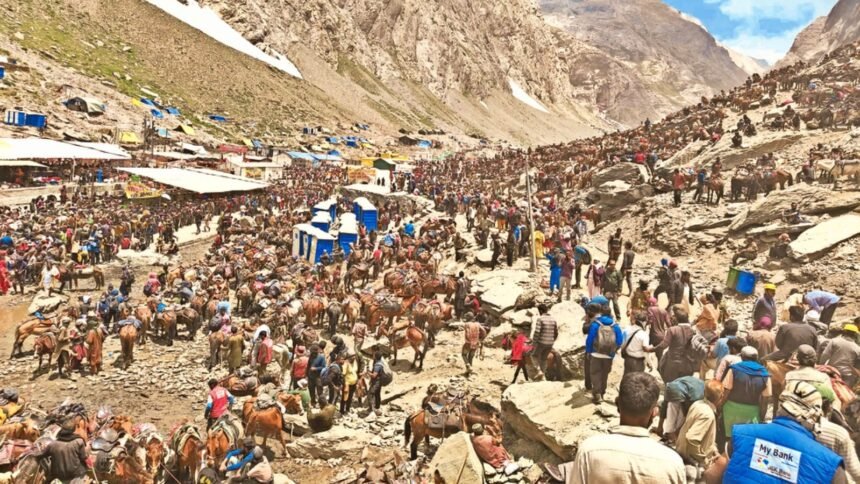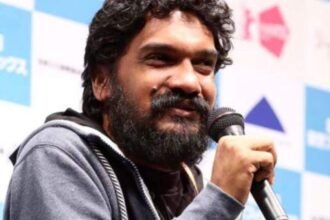Outside the Amarnath temple, ponies laden with elderly pilgrims make their way along treacherous paths, while porters move like worker ants across rock and snow. As they walk the final stretch towards the holy cave, an elderly man blesses his ponywala, Zulfiqar, “May you do well in life.”
Zulfiqar, 47, says his family has been doing seva at the Amarnath Yatra for decades now. “What happened in Pahalgam was an injustice. A ponywala like myself was killed defending the tourists,” he says, referring to the April 22 terror attack. “Seva is also part of our faith; our whole family depends on this yatra.”
The annual Amarnath Yatra is sustained by thousands of families like Zulfiqar’s — ponywalas and their sure-footed mountain horses from Anantnag, pithoos who carry heavy loads for miles, tent owners who provide shelter from the extreme climate, and drivers who help ferry everything from diesel generators to oxygen cylinders.
In fact, legend has it that the holy cave was discovered by a shepherd named Buta Malik in 1850. Malik was high up in the mountains with his herd when a Sufi saint gave him a bagful of coal. Opening the bag after returning home, Malik found it to be full of gold. The ecstatic shepherd ran to thank the saint but couldn’t find him; instead, he found the cave and the ice lingam.
Generations of men drawn from the remote villages of Anantnag district now symbolise this syncretic ethos of Kashmir, which was tested in the aftermath of the terror attack.
During the 38-day trekking season, a single ponywala earns Rs 2,000 per day, owing to fixed routes for each one. Each pony can carry up to 100 kg and make the journey multiple times daily during peak season.
Riyaz, who comes from Anantnag district and calls himself a Virat Kohli fan, says that “this time, everyone is on edge”.
Story continues below this ad
“I break the tension by debating with them on whether (Virat) Kohli should have retired or not. That takes their mind off things,” he says.
At Mahagunas Top, Dr Nilesh Kalsaria operates a hospital located at the highest point of the yatra route, at 14,000 feet, where he often has to deal with people complaining of oxygen deprivation. Dr Kalsaria has attended to over 390 patients so far. Today, patient number 29 is Qasar Ahmed, who is hooked to an oxygen cylinder.
This is the second stint at the hospital for Ahmed, who carries heavy loads to the highest peak. “Even though I am used to the altitude, this mountain takes a toll,” he says.
Earning around Rs 1,500 per day, he barely has time to recover as his customers wait outside. “My uncle died over 10 years ago after suffering a heart attack carrying heavy loads on this hill. I don’t think about it much. I help as much as I can,” he says.
Story continues below this ad
At the dusty tracks of Baltal, Omair Wani is the youngest person offering his services. At just 11 years old, he offers to carry heavy loads to the base camp, but hasn’t found any customer. “I can earn enough money to support 10 members of my family. My two elder brothers also work as porters. I haven’t found a single customer, so I am selling nimbu paani for now,” he says.
At Panchtarni, the last base camp before the holy cave, Abdul Dar’s tents were set up in a matter of weeks, with the largest accommodating 12 people. The infrastructure is deceptively simple but ingeniously designed. Each tent is anchored with stakes that could penetrate the frozen ground. Inside, thick carpets and blankets create an insulation barrier against the ground. A basic sleeping space costs Rs 600 per night, with premium services, including hot water, costing Rs 100 per bucket. During peak season, a single tent can generate revenue of Rs 15,000 to Rs 20,000 per day.
However, the cost to keep things running is equally staggering. Transportation of supplies alone consumes 15-30 per cent of the revenues. “People turn up here with altitude sickness, hypothermia and cardiac issues. We make a note of these yatris and check up on them. One yatri from UP could not go to the holy cave and did not have money to stay another night. We allowed him and his family another night’s stay, since space was available. Insaniyat is most important in this yatra,” he says.








